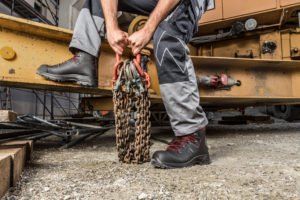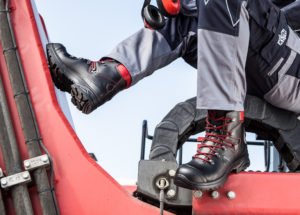PPE
Are complacent attitudes towards PPE compromising your business?
SHP speaks with Simon Ash, UK Sales Manager at HAIX, about how attitudes towards PPE can be detrimental to the safety of the individual, and the entire company.
 When it comes to PPE, as an employer, you have a legal duty to protect the health, safety and welfare of your employees while at work and provide suitable PPE to the entire workforce. Employers must do more than just have the equipment on the premises, by making sure it is readily available, properly assessed before use, fit for purpose, properly maintained and used correctly by employees. Failure to supply appropriate PPE or make sure it is being used by your workforce makes you liable to substantial fines and prosecution. There’s no room for improvisation or negligence. Read SHP’s Complete guide to Personal Protective Equipment, here.
When it comes to PPE, as an employer, you have a legal duty to protect the health, safety and welfare of your employees while at work and provide suitable PPE to the entire workforce. Employers must do more than just have the equipment on the premises, by making sure it is readily available, properly assessed before use, fit for purpose, properly maintained and used correctly by employees. Failure to supply appropriate PPE or make sure it is being used by your workforce makes you liable to substantial fines and prosecution. There’s no room for improvisation or negligence. Read SHP’s Complete guide to Personal Protective Equipment, here.
But, what happens if you provide all the PPE you need to but a worker chooses not to wear it? A complacent attitude towards PPE is not only frustrating after you’ve gone through the effort of sourcing and purchasing the best for your employees, but jeopardises the worker’s personal safety and the safety of others around him or her. Ultimately, the legal responsibility is yours and there could be serious consequences if an accident occurred and your employee was injured.
Negative attitudes towards PPE
As well as ensuring workers are equipped and using their PPE correctly, communicating and making sure your employees understand and appreciate the importance of wearing their PPE can be a challenge. Some workers may have a pre-conceived idea about PPE and be resistant to change or to wearing protective footwear all together. This issue tends to arise when a company is changing its protective equipment, particularly for longstanding employees that have been using the same workwear for years. SHP has produced the following ‘Buyer’s Guide’ on Safety Boots and Footwear.
PPE may be considered a hindrance by workers, with this feeling clouding better judgement. If workers don’t understand why they need to wear PPE, or don’t have any say in choosing it they are more likely to refuse to use it. Protective equipment, safety boots for instance, is something we expect workers to wear every day so it’s only natural that problems may arise if what’s provided to them is uncomfortable, not the right size, or cumbersome and unattractive. Wearer acceptance is the biggest hurdle to overcome in devising an effective PPE programme.
The first step in avoiding an unhappy workforce is by choosing the right equipment from the start and by taking into account your workers’ PPE personal preferences. Ask your workers about their current PPE, what it is they like and don’t like about it and show them the options you are thinking of purchasing. Having this conversation and giving them a choice may make them more likely to accept it, and will also give them a sense of empowerment in that they’ve contributed to the selection process.
Sometimes, however, this conversation is not enough and you may need a harder sell. Discuss with your workforce the consequences of not wearing their PPE – what is the worst case scenario if their foot is crushed by heavy machinery, or they mistakenly step on a sharp object. Use anecdotal stories and experiences to hone in on why PPE is in place for your employees, protecting them from the hazards and the potential injuries that they may actually be exposed to. You can talk about the bigger picture and the wider implications – if workers are not complying with PPE rules and someone is injured, the organisation could face prosecution, even imprisonment, and the company’s reputation could suffer.
Demonstrating the real, positive impact that PPE has and encouraging an open conversation should drive a positive change in culture, allowing your workforce to understand how PPE, selected with them in mind, can help them to be more productive and safer at work.
Educating about foot safety
 Of all the PPE, footwear may not seem as critical to workplace safety. Workers may forgo their foot protection believing they’ll be safe. However, slips and trips are common causes of injury at work, on average causing over a third of all major injuries . The concern is about individuals heading to work in non-specialist footwear or fashion trainers, compromising their safety.
Of all the PPE, footwear may not seem as critical to workplace safety. Workers may forgo their foot protection believing they’ll be safe. However, slips and trips are common causes of injury at work, on average causing over a third of all major injuries . The concern is about individuals heading to work in non-specialist footwear or fashion trainers, compromising their safety.
Foot and leg protection protects against a wide range of dangers at work, including crushing, slipping, piercing, temperature extremes, electricity, chemicals, cutting, and chopping. Depending on the hazard, various PPE options with specific safety features may be more suitable, for example; high quality protective footwear with S3 protection that defends against midsole penetration resistance, which also provides posture support and boasts high levels of comfort, is ideal for industrial working conditions. For a high level of safety required for those working in forestry, safety boots with chainsaw cut class protection and excellent durable and waterproof features is needed, class 1 being the lowest allowable level of safety protection provided by boots. There is no one shoe fits all rule – footwear needs are different specific to the industry, working environment and the role of the worker. It is critical that footwear is purchased after a full risk assessment, with the wearer in mind, or better yet with their contribution.
In order for an organisation to develop a strong safety culture, particularly when it comes to PPE, action must start from the top with senior management. If you as the leader the company are not following through with your own rules when you step out onto the shop floor, how can you expect your workforce to? Being seen to embrace the rules yourself will inspire trust in your leadership and demonstrate the commitment from management to back the PPE policy. In the end, without the involvement and support from senior management a positive change in safety behaviour is less likely to be sustained.
Are complacent attitudes towards PPE compromising your business?
Complacent attitudes towards PPE can be detrimental to the safety of the individual, and the entire company.
Safety & Health Practitioner
SHP - Health and Safety News, Legislation, PPE, CPD and Resources Related Topics
Inclusivity in PPE: The manufacturer’s perspective
Future-proofing safety: Five trends shaping the PPE landscape of tomorrow
Arco backs SHP campaign for PPE inclusivity

 When it comes to PPE, as an employer, you have a legal duty to protect the health, safety and welfare of your employees while at work and provide suitable PPE to the entire workforce. Employers must do more than just have the equipment on the premises, by making sure it is readily available, properly assessed before use, fit for purpose, properly maintained and used correctly by employees. Failure to
When it comes to PPE, as an employer, you have a legal duty to protect the health, safety and welfare of your employees while at work and provide suitable PPE to the entire workforce. Employers must do more than just have the equipment on the premises, by making sure it is readily available, properly assessed before use, fit for purpose, properly maintained and used correctly by employees. Failure to  Of all the PPE, footwear may not seem as critical to workplace safety. Workers may forgo their foot protection believing they’ll be safe. However,
Of all the PPE, footwear may not seem as critical to workplace safety. Workers may forgo their foot protection believing they’ll be safe. However,
Over use of PPE is dangerous, as it can be the result of a lazy employer not designing the work to avoid its need. Also if staff know this or all of it is just expected to be worn at all times it can help foster a poor culture and possibly failure to wear PPE when really needed… What do people think?
Paul, totally agree. The other factor is when employers imposed blanket requirements for PPE to be worn at all times to make policing easier, even if the hazard does not exist in the area they are working in.
Hazards should be engineered out first before considering PPE and not the other way around.
Since the HSE Better Display Screen RR 561 2007 reported 58% of DSE operators are suffering the debilitating affects of using sub-optimal and unmitigated display screen ergonomics concluding that the UK DSE Regulation are basically completely ineffective in prevention or mitigation this has to be another area where PPE is no more than tokenistic and no more than a tick-box exercise!!